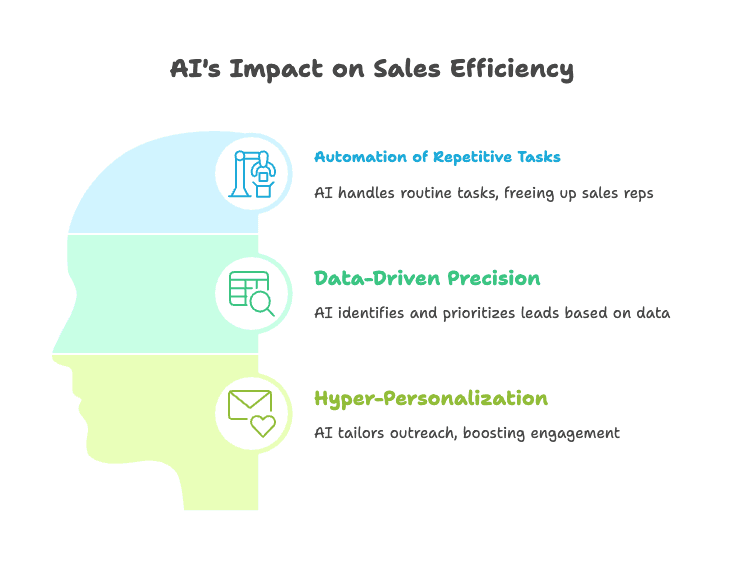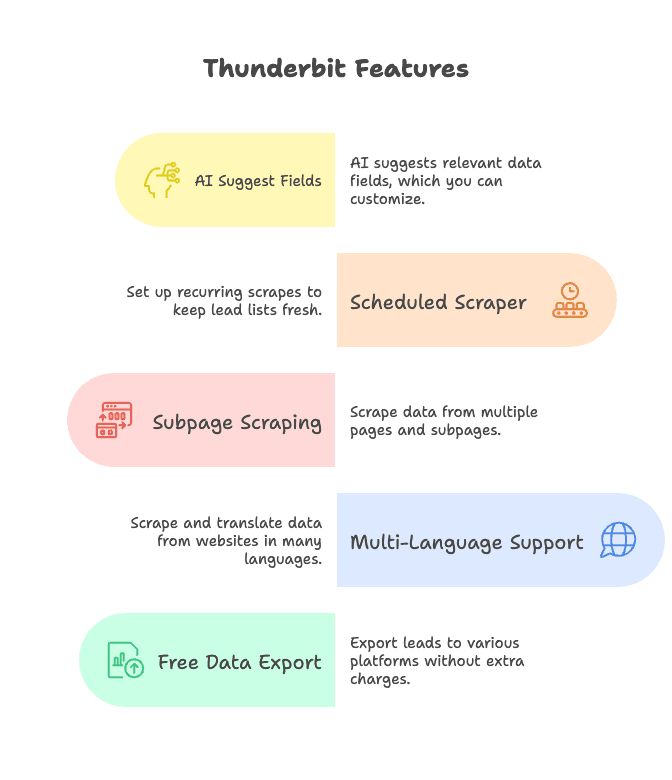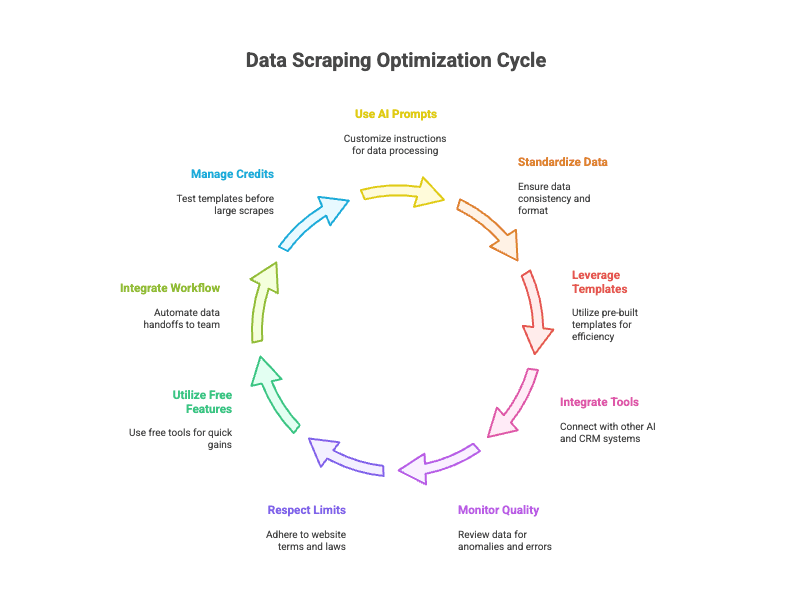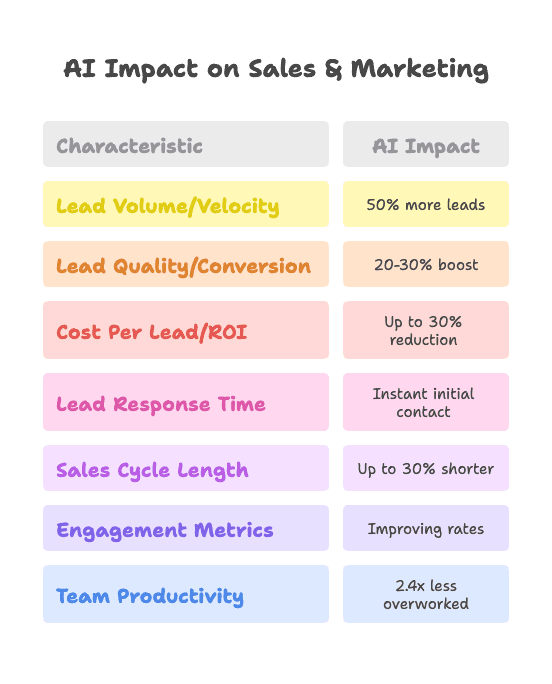I still remember the first time I tried to build a sales prospect list by hand. It was a classic “Ctrl+C, Ctrl+V” marathon—copying names, emails, and company info from a directory into a spreadsheet, one row at a time. After a few hours, my eyes glazed over, my coffee went cold, and I had maybe 50 leads (and a newfound appreciation for anyone who’s ever done manual data entry). Fast forward to 2025, and the landscape couldn’t look more different. AI lead generation is now the secret sauce behind the fastest-growing sales teams, and business AI software is transforming the way we find, qualify, and engage prospects.
If you’re in sales or operations, you’ve probably noticed the buzzwords: “seamless AI,” “AI-powered workflows,” “business AI software.” But what does it all really mean for your day-to-day? In this guide, I’ll break down the latest trends, share practical strategies, and show you exactly how tools like can help you unlock a new level of productivity—without needing a PhD in data science or a tolerance for spreadsheet-induced carpal tunnel.
Why AI Lead Generation Is a Must-Have for Modern Sales Teams
Let’s be honest: the old way of generating leads was a slog. Sales reps spent hours researching, copying data, and sending out generic emails—only to find that most leads were either outdated or unresponsive. In 2025, that’s no longer sustainable. The numbers tell the story: , and .
So why the rush to adopt AI lead generation? Here’s what’s changed:
- Automation of Repetitive Tasks: AI tools now handle the grunt work—data entry, list building, and even the first round of outreach—so sales reps can focus on selling and building relationships.
- Data-Driven Precision: Instead of guessing who to contact next, AI helps teams identify, qualify, and prioritize leads based on real-time data and predictive models.
- Hyper-Personalization: AI engines can tailor outreach to each prospect, boosting engagement and response rates. One SaaS company even saw a after switching to AI-personalized content.

The result? Companies using AI for lead generation report . In today’s hyper-competitive market, AI isn’t just a nice-to-have—it’s the difference between hitting your targets and falling behind.
What Is AI Lead Generation? A Simple Breakdown
Let’s demystify the jargon. At its core, AI lead generation means using artificial intelligence to automatically identify, attract, and nurture potential customers. Think of it as having a virtual assistant who can:
- Scan the web for prospects,
- Gather and enrich their information,
- Personalize outreach messages,
- And even follow up—all at a scale and speed no human could match.
Business AI software refers to platforms that put this power in your hands, often through user-friendly interfaces like Chrome extensions or web apps. You don’t need to code or hire a data scientist; you just tell the AI what you want, and it does the heavy lifting.
The big shift from traditional to AI-powered lead generation looks like this:
| Traditional Lead Gen | AI-Powered Lead Gen |
|---|---|
| Manual research, copy-paste lists | AI scrapes and structures data automatically |
| Generic, one-size-fits-all outreach | Hyper-personalized, data-driven messaging |
| Slow, error-prone, and hard to scale | Fast, accurate, and infinitely scalable |
And when people talk about seamless AI, they mean tools that integrate so smoothly into your workflow that even non-technical users can harness them. For example, with , you can literally ask the AI to “find all contact names and emails on this page,” and it’ll do the rest.
The 2025 Landscape: Types of AI Lead Generation Tools to Watch
AI has exploded into every corner of the lead generation process. Here’s a quick tour of the main categories you’ll encounter in 2025:
| Tool Type | What It Does | Example Platforms | When to Use |
|---|---|---|---|
| Contact Data Enrichment | Provides and updates lead contact info (emails, phone, firmographics) via large AI-updated databases | ZoomInfo, Clearbit, Lusha | When you have basic leads and need full, accurate contact details |
| AI Outreach & Engagement | Automates personalized outreach across email, chat, etc., using AI to tailor messages and timing | Outreach.io Pricing, Apollo, Drift | When you need to scale outbound campaigns or website lead capture |
| Predictive Scoring & Analytics | Ranks and prioritizes leads by likelihood to convert; analyzes patterns to guide sales focus | 6sense, Salesforce Einstein, HubSpot AI | When you have more leads than your team can handle and must focus on the best |
| AI Web Scraping & Mining | Extracts structured data (lead lists, contacts) from websites, social media, documents—no coding needed | Thunderbit, Apify, PhantomBuster | When the leads you need are listed on specific sites or scattered online |
Most high-performing teams combine several of these tools. For example, you might use web scraping to build an initial list, enrichment tools to fill in missing info, predictive scoring to prioritize, and an outreach platform to automate follow-ups. The common thread? AI enables scale and intelligence at every step.
Thunderbit: AI Lead Generation That Empowers Sales Teams
Now, let’s talk about where fits in. As someone who’s spent years building and testing automation tools, I’m genuinely excited about what Thunderbit brings to the table for sales and operations teams. Thunderbit is an AI-powered web scraper and automation agent that lets you turn any website into a structured lead database—no code, no fuss.
What Makes Thunderbit Different?
- AI Suggest Fields: Thunderbit’s AI reads the page and suggests the most relevant data fields (like Name, Company, Email, Role, Industry). You can accept, tweak, or add your own.
- Scheduled Scraper: Set up recurring scrapes from sources like event pages, job boards, or company directories. Thunderbit will keep your lead lists fresh—automatically.
- Subpage and Pagination Scraping: Need to click through multiple pages or visit subpages for more details? Thunderbit handles that, too.
- Multi-Language Support: Scrape and translate data from websites in over 50 languages—perfect for global teams.
- Free Data Export: Export your leads to Excel, Google Sheets, Airtable, or Notion, with no extra charges.
 Thunderbit is designed for non-technical users. If you can use a browser, you can use Thunderbit. It’s like having an intern who never gets tired, never makes typos, and never asks for a raise.
Thunderbit is designed for non-technical users. If you can use a browser, you can use Thunderbit. It’s like having an intern who never gets tired, never makes typos, and never asks for a raise.
Thunderbit’s Scheduled Scraper: High-Frequency, Structured Lead Input
This is one of my favorite features. With Scheduled Scraper, you can automate recurring lead data collection from any source—think event attendee lists, job postings, or new company directories. Here’s how it works:
- Automated Data Collection: Set Thunderbit to scrape a page (or list of pages) on a schedule you define—daily, weekly, hourly, you name it.
- AI Field Recognition: The AI identifies and extracts fields like company name, contact, email, role, and industry, and standardizes them for you.
- Handles Complex Structures: Thunderbit can navigate pagination and subpages, so you get complete profiles, not just surface-level info.
- Global Ready: Scrape pages in any language, and use AI prompts to translate or standardize fields for your team.
Imagine you’re tracking new job postings at target companies. With Thunderbit, you can have a live feed of hiring manager contacts delivered to your CRM every morning—no more manual research.
Step-by-Step Guide: Using Thunderbit for Seamless AI Lead Generation
Let’s get practical. Here’s how I’d set up Thunderbit for lead generation, step by step:
1. Install the Thunderbit Chrome Extension
- Head to the .
- Click “Add to Chrome” and create a Thunderbit account (the free tier is a great way to start).
2. Navigate to Your Target Website
- Open the web page you want to scrape—could be a directory, job board, or event attendee list.
3. Open Thunderbit and Select Your Data Source
- Click the Thunderbit icon in your browser.
- Choose “Current Page” as your data source (or input a list of URLs for batch scraping).
- If the page has pagination or infinite scroll, let Thunderbit auto-detect or set it manually.
4. Create or Choose a Scraper Template
- Click “+ New Scraper Template.”
- Hit the AI Suggest Columns button. Thunderbit’s AI will scan the page and propose relevant fields (e.g., Name, Company, Email).
- Edit, add, or remove columns as needed. Set data types (Text, Number, Email, etc.) for each field.
- Add custom AI prompts for advanced extraction, like “Format phone number in E.164” or “Translate description to English.”
5. Scrape the Data
- Click “Scrape.” Thunderbit will extract the data from the page (and all paginated/subpages if enabled).
- Preview the results in a table. If something looks off, tweak the template or prompts and run again.
6. Subpage Scraping (Optional)
- If you have a column with URLs (like profile links), trigger Subpage Scraping.
- Define additional fields to extract from each subpage (e.g., About Us, LinkedIn URL).
- Thunderbit will visit each link, extract the info, and append it to your main table.
7. Export Your Data
- Export to Excel/CSV, Google Sheets, Airtable, or Notion in one click.
- All exports are free and unlimited—even on the free plan.
8. Schedule for Automation (Optional)
- Go to the “Schedule” tab in Thunderbit.
- Enter the URLs to monitor and describe the frequency (“daily at 9:00 AM”).
- Choose where to send the results (e.g., overwrite a Google Sheet).
- Thunderbit will keep your lead list updated automatically.
9. Choose Cloud or Browser Mode
- Use Cloud Mode for large, public jobs (scrapes up to 50 pages in parallel).
- Use Browser Mode for sites that require your login or session.
10. Leverage Templates and Playground
- Check Thunderbit’s Template Gallery for instant templates (e.g., LinkedIn Sales Navigator Scraper).
- Use Playground mode to test scrapes before using credits.
For a visual walkthrough, Thunderbit’s is packed with screenshots and tips.
Pro Tips for Maximizing Thunderbit’s AI Lead Generation
After helping hundreds of teams get started with Thunderbit, here are my top tips for getting the most out of it:
- Use Field AI Prompts: Add custom instructions to clean, format, or translate data as it’s scraped. For example, “Extract job title before the word ‘at’,” or “Translate company description to English.”
- Standardize Data: Prompt the AI to format phone numbers, split/merge name fields, or categorize companies by industry.
- Leverage Instant Templates: For popular sites, use Thunderbit’s pre-built templates—they’re fast and battle-tested.
- Combine with Other AI Tools: Export leads to Google Sheets, then use AI writing assistants to draft personalized emails, or connect to your CRM via Zapier.
- Monitor Data Quality: Regularly review scraped data for anomalies, and refine prompts or templates as needed.
- Respect Website Limits: Use polite scraping intervals and comply with terms of service and privacy laws.
- Take Advantage of Free Features: The Email and Phone Extractors are totally free—great for quick wins.
- Integrate with Your Workflow: Set up exports to your team’s preferred tools, and automate handoffs where possible.
- Keep an Eye on Credits: Use Playground mode to test templates before running large scrapes.
 The more you experiment and iterate, the better your results will get. Thunderbit’s AI is like a colleague—give it clear instructions, and it’ll deliver.
The more you experiment and iterate, the better your results will get. Thunderbit’s AI is like a colleague—give it clear instructions, and it’ll deliver.
Overcoming Challenges in AI Lead Generation
AI lead generation isn’t all sunshine and rainbows. Here are some common challenges—and how to tackle them:
- Data Quality: AI is only as good as the data it works with. Regularly clean and enrich your database, validate emails, and cross-check with multiple sources. Use Thunderbit’s data enrichment prompts to standardize and verify fields.
- Integration: Avoid data silos by integrating AI tools with your CRM and workflow. Thunderbit exports to Sheets, Notion, and Airtable, and you can use Zapier for further automation.
- User Adoption: Change can be scary. Train your team, show quick wins, and emphasize that AI is here to help—not replace—your sales reps.
- Over-Reliance on AI: Always keep a human in the loop. Sanity-check AI outputs, review critical decisions, and use explainable AI features where possible.
- Compliance and Ethics: Respect privacy laws (GDPR, CAN-SPAM, etc.), avoid scraping sensitive data, and be transparent with leads about how you found their info.
- Measuring ROI: Set clear KPIs (lead volume, quality, cost per lead, conversion rates) and track them before and after adopting AI tools.
Addressing these challenges early will set you up for long-term success.
Measuring Success: KPIs for AI Lead Generation in 2025
How do you know if your AI lead generation is working? Here are the key metrics to track:

- Lead Volume and Velocity: Are you generating more leads, faster? .
- Lead Quality and Conversion Rate: What percentage of AI-generated leads become qualified opportunities? .
- Cost per Lead and ROI: Are you lowering your cost per lead? .
- Lead Response Time: How quickly are you following up? AI tools can make initial contact instant, especially with chatbots.
- Sales Cycle Length: Are deals closing faster? .
- Engagement Metrics: Are open, click, and reply rates improving with AI-personalized outreach?
- Team Productivity: Are reps spending more time selling and less on admin? .
Set up dashboards in your CRM or Sheets to monitor these KPIs, and celebrate improvements with your team.
The Future of Seamless AI in Lead Generation
Looking ahead, the fusion of AI and lead generation will only deepen. Here are some trends I’m watching:
- Autonomous AI Agents: Imagine AI sales reps that can find, qualify, and even contact leads autonomously.
- One-to-One Personalization: AI will generate personalized videos, dynamic web experiences, and tailored proposals for each lead.
- Predictive Analytics Everywhere: By 2027, to guide lead gen.
- Voice and Visual Search: AI will mediate more discovery, so optimizing for AI-driven search will be key.
- AI-First CRMs: CRM platforms will become active AI co-workers, not just passive databases.
- Privacy and Ethics: Expect more regulation and a shift toward privacy-centric, ethical AI lead gen.
- The Human Touch: As AI handles the grunt work, the human element—relationship building, empathy, creativity—will become even more valuable.
The bottom line? Stay agile, keep experimenting, and treat AI as your co-pilot, not your replacement.
Conclusion: Key Takeaways for Sales and Operations Teams
- AI Lead Generation Delivers Results: Companies using AI are generating , and are more likely to hit revenue targets.
- Transition from Manual to AI-Driven Workflows: Audit your current process, identify tasks to automate, and let AI handle the repetitive work.
- Leverage the Right Tools: Use a mix of enrichment, outreach, scoring, and web scraping tools. Try for easy, AI-powered data extraction—even if you’re not technical.
- Start Small, Iterate Fast: Begin with quick wins (like Thunderbit’s free Email Extractor), then expand. Use the step-by-step guide and pro tips to get up to speed.
- Integrate and Measure: Make sure AI outputs flow into your CRM or workflow, and track KPIs to prove value.
- Stay Ethical and Human: Respect privacy, comply with laws, and use AI to enhance—not replace—the human touch.
The future of lead generation is here, and it’s powered by seamless AI. Whether you’re a sales manager, SDR, or marketing ops specialist, now is the time to start experimenting. Download Thunderbit, try scraping a few prospect lists, and see how much time you save. The sooner you start, the sooner you’ll see results.
Ready to unlock a new era of lead generation? and join the ranks of teams who are turning AI into their competitive edge.
Curious for more? Check out the for deep dives on scraping , , or even . And if you want to see Thunderbit in action, don’t miss the .
FAQs
1. What is AI lead generation and how is it different from traditional methods?
AI lead generation uses artificial intelligence to automate the process of identifying, enriching, and reaching out to potential customers. Unlike traditional methods that rely on manual research and generic outreach, AI tools scrape data, personalize messages, and score leads based on real-time insights—making the process faster, more accurate, and easier to scale.
2. What types of AI tools are used for lead generation in 2025?
AI lead generation tools fall into several categories:
- Contact enrichment tools (like ZoomInfo or Clearbit) that fill in lead details,
- Outreach automation platforms (like Apollo or Drift) that send personalized messages,
- Predictive analytics software (like 6sense or Salesforce Einstein) that score leads,
- AI-powered scrapers (like Thunderbit) that collect structured lead data from websites without coding.
3. How does Thunderbit help with AI-powered lead generation?
Thunderbit is a no-code AI web scraper that turns websites into structured lead databases. It suggests relevant fields, handles pagination and subpages, supports multi-language scraping, and allows users to schedule automated scrapes. Users can export data to Google Sheets, Notion, Airtable, and more—making lead generation fast, easy, and scalable.
4. What are some best practices when using AI for lead generation?
To get the most from AI tools:
- Use AI prompts to clean and standardize scraped data,
- Leverage templates for faster setup,
- Integrate exports with your CRM,
- Monitor data quality regularly,
- Always follow ethical and legal guidelines, including GDPR and CAN-SPAM compliance.
5. What key metrics should teams track to measure AI lead generation success?
Track KPIs such as:
- Lead volume and velocity,
- Conversion rates and lead quality,
- Cost per lead and overall ROI,
- Response times and sales cycle length,
- Engagement metrics like open/click rates,
- Team productivity improvements. Monitoring these helps teams validate AI effectiveness and improve over time.